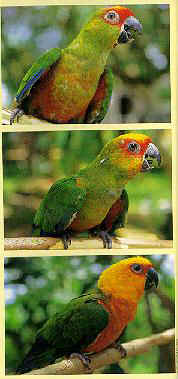
Middle: Gold-capped conure (Aratinga auricapilla auricapilla)
Bottom: Jenday conure (Aratinga jandaya)
 | Top: Gold-capped conure (Aratinga auricapilla aurifrons) Middle: Gold-capped conure (Aratinga auricapilla auricapilla) Bottom: Jenday conure (Aratinga jandaya) |
Most texts show the gold-capped, jenday and sun conures to be three distinct species of the same genus, named Aratinga. This arrangement shows the relationship between the three to be no different than the relationship between the sun conure and the mitred conure. To the majority of aviculturists who have worked with suns, jendays and gold caps, however, it is obvious that a much closer relationship exists between these three conures than just the genus name Aratinga would imply.
These birds have proven to be reliable and prolific breeders in captivity. Indeed, we at Voren's Aviaries have produced over
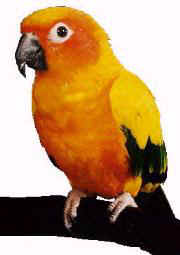 | Sun conure (Aratinga solstitilis) |
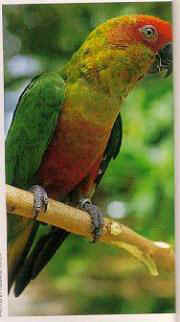 | This conure is a male redheaded gold cap |
Immature birds of both subspecies can look alike. Therefore, it may be impossible to distinguish between the two until they acquire their adult coloration. This usually happens by the time the birds are 1 year old. Full adult coloration is not achieved until the birds are 2 years of age. The color of the periophthalmic ring (skin around the eye) in both subspecies ranges from medium gray to black, depending on how much
 | Human intervention with highly colored speciments produced this super-colored gold cap. Note the close similarity to jenday coloration. |
During the short period of time they were imported, I had the good fortune to inspect a group of over 800 specimens. From this group, I selected several aberrant examples. These birds had either an unusual type of coloration or had the normal coloration extending onto parts of the head that were normally green. I also selected about a dozen normal-looking specimens in order to try to set up a small captive breeding population. This group was kept as a flock for about six months.
During this time, they were quarantined, acclimated and surgically sexed. When I was ready to split them up into
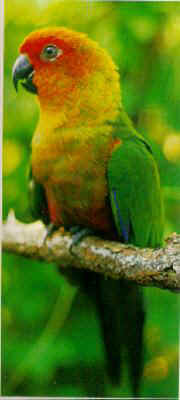 | This highly colored gold cap resulted from the personal choice of birds being attracted to mates of highest coloration |
I was very surprised when my observations revealed that all of the most colorful birds had paired with each other. I allowed them to stay together and waited to see what their offspring would look like. Most of the babies were more colorful than their parents. These overly colorful offspring were placed in a holding flight with the offspring that were of normal coloration, from normally colored parents. Again, the most colorful birds attracted the most colorful mates. In fact, what was happening was the birds were creating a new color variety of the gold-capped conure, as a product of their own limited free-choice pairing. In all cases, the highly colored birds had the opportunity to pair with normally colored birds, and in almost all cases they chose mates that were as aberrant as themselves. This was an excellent example of how new subspecies can be created in isolated populations.
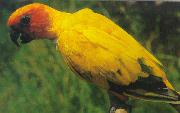 | This adult sun conure is nearly all yellow |
After the third generation of birds started making the same type of choices, I no longer felt guilty about my desire to begin selective breeding for color. After all, there was no reason to keep offering normally colored birds to those that were of high coloration; since they had demonstrated through three generations that that was not what they wanted. Now, 10 years later, we have two unique color variations of the gold-capped
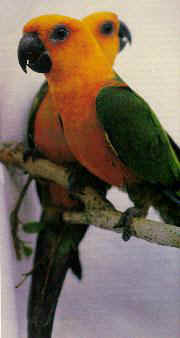 | These black-eyed jendays represent a currently unrecognized, highly pigmented race. |
The first type has the yellow of the top of the head extending with a speckled effect through the hindcrown up to the nape. The ear coverts are speckled with orange-red, as are as the lower cheeks. The extent of the coloration upon adulthood appears to be governed by sex, the most extensively colored birds being females.
The second color variation was due to one uniquely colored wild-caught male. He stood out like a sore thumb from the original group of 800 birds that I observed. The normal range of color on the top of the head goes from red-orange to yellow from the forehead back to the crown. This specimen's coloration went from deep red to red-orange on the top of the head and showed red to red-orange markings on both the ear coverts and lower cheeks. He also had a much lighter pigmentation in the eyes. This gave the eyes an almost blue-gray appearance. We are now producing fourth
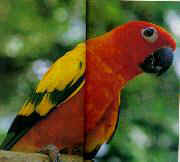 | Floidian George Scheibe produced this beautiful red sun conure in his aviary. Scheibe has established a line of particularly beautiful red suns |
With the gold cap's propensity to seek out the most highly colored mates possible, it seems logical to me that A. a. aurifrons did not evolve from A. a. auricapilla, but vice versa.
Recent investigation has shown that the gold cap is quickly becoming rare throughout its range. Their addition to CITES Appendix I has been under consideration. It probably will not be added at this point because commercial exploitation of the wild flocks has all but ceased.
On a positive note, many American aviculturists with extensive collections of conures recognized gold caps for the unique rarity that they were. During the short period of time that they were imported, these aviculturists ignored the popular trend of setting up more and more pairs of the more brightly colored jenday and sun conures. Instead, they made sure that there was room in their aviaries for this relatively unknown member of the triad. Today, these wise aviculturists have a treasure that will never again be imported. With the broad base that this bird now enjoys in aviaries throughout the United States, I am sure that the gold-capped conure has secured a permanent place in aviculture.
The jenday is a bird that had the good fortune to be purchased almost exclusively by breeders while it was being imported. They have been, on the whole, only fair breeders but excellent parents. They can go to nest at almost any time of the year, unless the weather is too hot. Nestlings number two to four and make excellent pets when handraised. Their requirements are exactly the same as for the gold-capped and sun conures.
The breeding flights that I use are 4 feet in length and 2 feet square. All flights are placed on galvanized pipe benches that keep them 4 feet off the ground. I use standard, medium sized conure nest boxes. They are plywood with a wire lining. They measure 12 inches square and 16 inches deep. The weld wire lining is necessary to keep them from emptying the bottom of the box of the pine shavings that I give them for nesting material.
There are no subspecies listed for the jenday, which carries the scientific name Aratinga jandaya. I do, however, believe that there is sufficient evidence to suggest the existence of a subspecies. This is due to the fact that the wild-caught jendays that were imported presented themselves in two distinct forms.
The first form is the one that we are all used to seeing. The points to concentrate on when comparisons are made is the periophthalmic ring (around the eye) and the color of the breast. The periophthalmic ring varies from white to less-than-medium gray, depending on how much time the birds spend in the sun. The grayish coloration is similar to a suntan in humans. The breast color ranges from orange to orange-red, and the abdomen is orange-red. The unnamed subspecies is a bird of much heavier pigmentation. The periophthalmic ring ranges from medium gray to black, again depending on how much time the bird spends in the sun. The breast and abdomen range from red-orange to red. This bird is extremely beautiful. I call it the black-eyed jenday.
One must be very careful when searching for specimens of this type. The problem is the sunday conure (jenday x sun) hybrid. Although, personally, there are some hybrids that I approve of, I think the sunday is one that should be discontinued. Whenever a hybrid looks similar enough to either of the original parent species as to cause possible confusion between it and a purebred specimen, it should be placed in a situation where it can never be bred. The sunday looks almost identical to the black-eyed jenday in body coloration. Even though most of the aviculturists that produce this hybrid sell them to be used as pet stock only, many of these birds recirculate into breeding collections. The pet owner may get tired of his bird and sell it to a pet shop that does not know the history of the bird. They in turn may sell or trade the bird to a breeder as a mature jenday. The unknowing aviculturist pairs it with one of his jendays to produce offspring that can be used to introduce new blood into his flock. Unfortunately, the offspring will be 25-percent sun conure. This is no way to increase your gene pool.
The key factor in determining whether you have a purebred black-eyed jenday or a sunday is the pigmentation of the periophthalmic skin. On a sunday, the skin will be white to light gray. On a black-eyed jenday, the skin will be medium gray to black, depending on sun exposure. The black-eyed jenday often is a bit redder than the sunday, but this is too subjective a criteria to be used with accuracy. The best rule of thumb to follow is the color of the skin around the eye. For this reason, I chose to refer to this bird as the black-eyed jenday instead of the red jenday. I propose the scientific name Aratinga jandaya negra.
Field studies will have to be done in order to determine the black-eyed jenday's exact range, but I can personally say that I have definitely verified their existence in the jungles of Brazil. While I was in South America waiting to escort a shipment of birds to the United States, a collector there received a group of 20 specimens that were going to be sent to Europe. All of them were of the black-eyed type. She had no idea that they were such a rare variety. She had purchased them from a Brazilian bird trader but never bothered to ask in what part of Brazil they were captured.
At one point in time, the sun conure was considered to be more rare and valuable than the Queen of Bavaria conure, Aratinga guarouba (also called the golden conure). Unheard-of prices were being offered for pairs of these birds because they were almost nonexistent in the United States. Around 1975, the exploitation of wild flocks in Surinam and Guyana started, and several large shipments began entering the United States. Due to the mass availability of sun conures at the time, the price quickly plummeted from several thousand dollars per bird to about two hundred dollars. Within six years, importation all but stopped. This was due to a combination of price increases in the countries of origin as well as disease problems that were taking place in quarantine.
Today, the demand for sun conures is supplied completely by domestic breeding, as is the case with both the jenday and the gold cap. The wholesale price has, of course, risen quite a bit, but the buyers are now getting healthy, domestically produced stock.
The requirements for breeding and maintaining suns is exactly the same as for the jenday and gold-capped conures. In South Florida, they usually start nesting in November and breed continually until about August. At this point, the weather is too hot to continue breeding. They will finish up the clutch that they are involved with and rest until the weather cools again in November. The number of nestlings produced in one season by good pairs should average around 10. Our record production for babies hatched and raised for 10 days by one pair is 23 in one season. After hatchlings reach about 10 days of age, they are pulled for hand-raising. This gives the parents a chance to go back to nest sooner. It also relieves the parents of the most stressful time in raising babies--feeding a clutch of large chicks whose appetites never end. Hand-raised babies make excellent and extraordinarily beautiful pets.
There are no named subspecies of the sun conure, but there is a good possibility that one does, indeed, exist. It is a highly pigmented version of the typical sun conure. The periophthalmic skin is gray to black, depending on sun exposure. Also, the reddish wash to the yellow facial and body feathers is increased to the point that it gives the bird a red-orange appearance. These birds are absolutely breathtaking. I know of one aviculturist who has worked extensively with this color variety. George Scheibe of Brooksville, Florida, has, through the years of working with specimens of this type, produced a domestic population of some of the most gorgeous conures I have ever seen. The specimens I have seen of this possible subspecies did not have the dark periophthalmic ring, but none of them were housed in the sun. Whether this is a separate subspecies or just a color variation is unknown. Rumor has it that this type originated in Brazil, but it could have just as easily filtered in from Venezuela. It would make an interesting field study trying to validate this possible subspecies.
At Voren's Aviaries, we have a variation of the sun conure that is due to the bloodline of one wild-caught male that I purchased about 17 years ago. Sun conures in their immature plumage are drastically different than adults. Almost all fledgling suns are completely green on their wings. They also have a green suffusion from the belly that continues up through the breast to the cheeks. Normal adult coloration appears slowly over a 2- to 3-year period. We are now producing fledglings that have between 40 and 90 percent of their adult coloration with their first set of feathers. Upon reaching adulthood, some of the very yellow offspring have much more yellow on the wings than any of the normal suns.
The status of this bird in captivity is impressively secure. They have produced marvelously in almost every aviary that they occupy, and their popularity has risen dramatically. Although they have a tendency to be quite noisy--sometimes more than the jenday and gold cap--their colorful plumage more than makes up for this drawback. Their beautiful coloration and stable price make them a bird that remains in high demand by both pet owners and breeders alike.
A genus is a group of different living things with common distinguishing characteristics that are related by prehistoric genetic origin.
A species is a group of freely interbreeding individuals that will not interbreed with other members of the same genus in its natural environment.
Subspecies are the local geographical variations of the same species. The variation usually involves size and (or) coloration differences that are consistent in all specimens from a particular region.
In order to be classified as a subspecies rather than a separate species, the variation must be willing to freely interbreed with other variations of the same species if the populations were brought together in their natural environment. A subspecies is a step toward the development of a new species. When the differences between subspecies becomes so great that they cease to recognize one another (in their natural habitat) as possible mates, then a new species has been created.
In aviculture, the gold-capped, jenday and sun conures can be treated as identical. Their courtship behavior, nesting, calling and movement habits are all the same--they are three color variations of the same bird. Whether they should be scientifically classified that way is another question.
After many years of carefully observing their pairing behavior, it becomes apparent how these color variations could have occurred. Before maturity and toughness has substantial meaning in the determination of what bird wins what mate, gold caps show a marked preference for the most extensively colored bird within their own group. In short, among themselves, the more extensive the coloration they have, the more beautiful they are. This preference took place with the original wild-caught group of gold caps that we started working with at Voren's Aviaries. Even though all birds were kept in the same flight, the specimens of abnormally heavy coloration all picked each other as mates. In fact, the attraction was so great between them that they were the first to pair up and start claiming territorial limits in the flight. Consequentially, after all the most colorful specimens paired, the birds with normal coloration chose mates among themselves. Due to the fact that this group of adult wild-caught birds showed similar pairing preferences to those of the immature captive-bred specimens we later raised, I assume that the birds' choices are made out of an appreciation of color (beauty) rather than because the babies have been influenced by being raised domestically. The birds being produced from the offspring of these pairings might well be considered as intermediate in coloration between the gold cap and jenday. These birds are purebred gold caps. They are not hybrids. In fact, I have seen examples of all the hybrids, and they look nothing like these birds.
After conducting these breedings, observing the pairing preferences and seeing the results, it seems quite probable that an isolated group of gold caps could have evolved into the jenday conure in a relatively short period of time. In fact, if one includes the black-eyed jenday subspecies, A. jandaya negra, in the lineup, the progression is more complete. This is due to the dark pigmentation of the periophthalmic ring, a trait that is shared by the gold cap.
With the jenday, I have not noticed any marked preference for other jendays of extreme coloration, but then again, the jenday is not a bird that has adult plumage as variable as either the sun or the gold cap. There are, however, domestically bred jendays showing up with some yellow flecking on the wings. I am sure that a good number of these are due to unknown sunday blood (sunday x jenday) somewhere in their background.
I do know for a fact that the yellow flecked jendays produced by us are the result of inbreeding pure wild-caught jenday stock. This yellow flecking that we see on inbred domestic stock could easily have started the evolution of the sun conure out of the jenday, if this same trait started showing up in an isolated group of jendays in the wild.
The sun conure could have also evolved directly from an isolated group of gold caps. The gold cap, as well as the sun, shows a preference for the most extensively colored available bird as a mate. This type of selective pairing preference can easily be responsible for the existence of the jenday and the possibly more highly inbred sun conure.
Taking this into consideration, let's look at the group of three from a different angle. If the above theories are correct, and the jenday was created by the inbreeding of overly colored gold cap specimens, and the sun was created in a similar way, we would expect to see certain differences in the birds that are not apparent from casual observations. We would expect to see some differences in size, production and hardiness of the three. The fact is that these differences do exist.
I have stated several times in this article that the gold-capped, jenday and sun conures are almost identical. Well, this is true in the same way that the normal green ringnecked parakeet is the same as its lutino mutation. The birds are essentially the same, but the creation of an overly yellow bird through inbreeding often results in a bird that is a bit smaller on the average and a bit less hardy than the normal specimen.
During almost 15 years of extensive breeding of these birds, I can say without a doubt that the gold cap as a nestling is chunkier in size, calmer in temperament, and more disease resistant than the jenday. The same can be said about the difference between the jenday and sun conure nestlings. This decrease in hardiness from the gold cap to the jenday to the sun conure is exactly what one would expect if the jenday were created by a isolated group of inbreeding gold caps, and, in turn, if the sun conure were created by an isolated group of inbreeding jendays or a group of highly inbred gold caps.
I must stress at this point that I am not saying that the sun conure is a skinny, nervous, disease-prone conure. In fact, this is far from the case. But there is a constant increase in hardiness as we pass from the sun to the jenday and back to the gold-capped conure. This is apparent when one reflects back on years of breeding and hand-raising results.
After making these observations, I believe that the sun, jenday and gold cap probably evolved in a manner similar to the one I have theorized. I believe that they were subspecies of one another at one time. But whether they are still subspecies of one another at present is another story.
We are short one criterion that needs to be satisfied if we are to consider them subspecies of one another at this time. That is the necessity that when different groups come together, they will freely interbreed. This is not the case with the gold cap, jenday and sun triad. Mixed groups of wild caught adults remain segregated and only pair with their own kind. True, they readily hybridize, but this is under unnatural conditions (i.e., when the three are hand-raised together). When adult, unpaired, wild caught specimens are housed together, they will pair with their own kind whenever possible.
This indicates that the triad has evolved past the point of being subspecies of one another. As stated previously, the development of a subspecies is a step in the evolution of a new species. When the differences become so great between subspecies that they no longer will interbreed by choice, they can be considered separate species within a single superspecies. This is the classification that seems most appropriate when all current knowledge is considered. The theorized progression from gold-capped to sun conure can easily be seen by viewing the photographs accompanying this article.
Howard Voren is the founder and director of the Voren Research Institute for Psittacultural Science. Voren is also the owner and operator of Voren's Aviaries Inc. in Florida, and has been a full-time professional aviculturist for more than 20 years.

 "This page was designed by Beakers Graphic Designs"
"This page was designed by Beakers Graphic Designs"